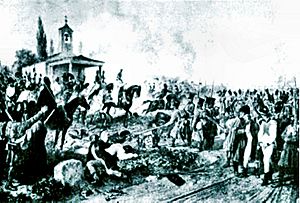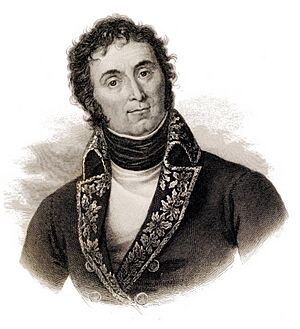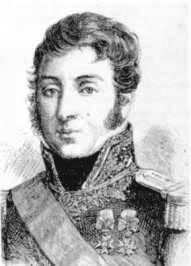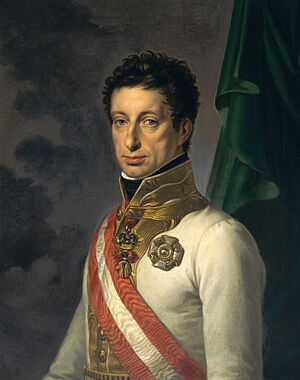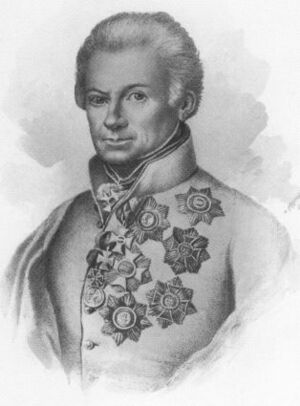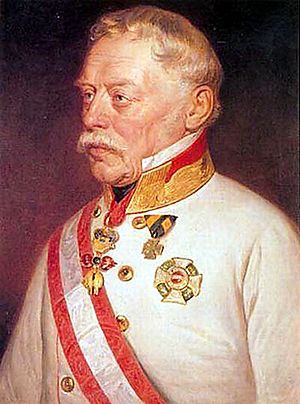Order of battle for the Battle of Caldiero (1805) facts for kids
The Battle of Caldiero was a big fight between the armies of France and Austria in 1805. It happened near Verona in Italy from October 29 to 31. This battle was part of the Napoleonic Wars, a time when Emperor Napoleon was very powerful in Europe.
The French Army of Italy was led by Marshal André Masséna. The Austrian Armee von Italien was commanded by Archduke Charles. Historians still debate who truly won the battle. Some say France won, some say Austria, and others say it was a draw.
Both sides lost many soldiers. Austria had over 5,500 casualties, and France lost at least 5,000. After the battle, Archduke Charles started to pull his army back from Italy on November 1. His army reached Kormend in western Hungary by early December. However, by then, Emperor Napoleon had already won a huge victory against the Austrian and Russian armies at the Battle of Austerlitz.
Contents
The French Army at Caldiero
The French army was called the Army of Italy. It was led by Marshal André Masséna. An "order of battle" is like a list showing how an army is organized. It tells you which units (like divisions or regiments) were part of the army and who was in charge of them.
Masséna's army was divided into different parts: a Left Wing, a Right Wing, and some troops north of Verona. There were also special reserve units.
French Left Wing
Marshal Masséna himself commanded the Left Wing. This part of the army had several divisions. A division is a large group of soldiers, usually led by a General.
- 1st Division: Led by General Gaspard Amédée Gardanne.
- This division included light infantry (soldiers who move fast) and line infantry (regular soldiers).
- It also had cavalry, like the 23rd Chasseurs à Cheval Regiment, who were light horsemen.
- 3rd Division: Led by General Gabriel Jean Joseph Molitor.
- This division had many battalions of line infantry. A battalion is a smaller group of soldiers within a regiment.
- The 29th Dragoon Regiment, a type of cavalry that could fight on horseback or on foot, was also with this division.
- 4th Division: Led by General Guillaume Philibert Duhesme.
- This division also had light and line infantry regiments.
- It included the 25th Chasseurs à Cheval Regiment.
French Reserve Forces
The French also had reserve troops. These soldiers were kept ready to join the fight when needed.
- Reserve Division: Led by General Louis Partouneaux.
- This division was made up of special "Carabinier" and "Grenadier" battalions. These were often elite, strong soldiers.
- Reserve Cavalry Division: Led by General Julien Augustin Joseph Mermet.
- This division included powerful "Cuirassier" regiments. Cuirassiers were heavy cavalry soldiers who wore armor.
- Light Cavalry Division: Led by General Jean Louis d'Espagne.
- This division had several Chasseurs à Cheval regiments, which were fast-moving cavalry.
French Right Wing
The Right Wing of the French army was commanded by General Jean-Antoine Verdier.
- 2nd Division: Also led by General Verdier.
- This division included light and line infantry.
- It had cavalry units like the 4th and 19th Chasseurs à Cheval Regiments.
- Cavalry Division: Led by General Charles Randon de Pully.
- This division had more heavy cavalry, like the 4th and 6th Cuirassier Regiments.
- It also included Dragoon regiments.
French Troops North of Verona
Some French troops were positioned north of Verona but did not take part in the main battle.
- 5th Division: Led by General Jean Mathieu Seras.
- This division included a special "Légion Corse" battalion and several light and line infantry regiments.
The Austrian Army at Caldiero
The Austrian army was called the Armee von Italien. It was led by Feldmarschall Archduke Charles. Before the war, Austrian infantry regiments were reorganized. Each regiment had four line battalions and one grenadier battalion. Each battalion had four companies, with about 160 soldiers in each company.
Austrian Right Wing
The Right Wing of the Austrian army was commanded by Feldmarschall-Leutnant Joseph Anton von Simbschen.
- Simbschen Division:
- This division included "Grenz Infantry" regiments. These were special border guard units.
- It also had "Hussar" regiments, which were light cavalry known for their speed.
- Several regular infantry regiments were also part of this wing.
Austrian Center
The Center of the Austrian army was commanded by General der Kavallerie Count Heinrich von Bellegarde.
- 1st Line Division: Led by Feldmarschall-Leutnant Ludwig von Vogelsang.
- This division had several infantry regiments.
- It also included many "Grenadier" battalions. These were often the best soldiers in the army.
- Cavalry Division: Led by Feldmarschall-Leutnant Andreas O'Reilly von Ballinlough.
- This division had "Chevau-léger" regiments (light cavalry) and Hussar regiments.
- 2nd Line Division: Led by Feldmarschall-Leutnant Karl Friedrich von Lindenau.
- This division also had many Grenadier battalions from different regiments.
- It included the "Esterhazy" Infantry Regiment.
- Another Cavalry Division: Led by Feldmarschall-Leutnant Prince Joseph of Lorraine-Vaudémont.
- This division had "Dragoon" regiments, which were cavalry that could fight on foot.
Austrian Left Wing
The Left Wing of the Austrian army was commanded by Feldmarschall-Leutnant Prince Heinrich XV of Reuss-Plauen.
- Reuss Division:
- This division included infantry regiments like "Vukassovich" and "Archduke Franz Carl."
- It also had several Grenadier battalions.
- The "Archduke Charles" Uhlan Regiment, a type of light cavalry armed with lances, was attached here.
Austrian Far Left Wing
The Far Left Wing was commanded by General-Major Armand von Nordmann.
- Nordmann Division:
- This division included more Grenz Infantry regiments.
- It also had the "Erdödy" Hussar Regiment.
Austrian Reserve
The Austrian Reserve was commanded by Feldmarschall-Leutnant Eugène-Guillaume Argenteau.
- Reserve Brigade: Led by General-Major Alois von Gavasini.
- This brigade had infantry regiments and the "Stipczic" Hussar Regiment.
Austrian Detached Corps
Some Austrian troops were in a "Detached Corps" led by Feldmarschall-Leutnant Paul Davidovich. These troops did not fight in the main battle.
- Rosenberg Division: Led by Feldmarschall-Leutnant Prince Franz Seraph of Rosenberg-Orsini.
- This division included Grenz Infantry and Hussar regiments. One brigade was led by General-Major Joseph Radetzky von Radetz, who later became a very famous Austrian general.
- Löwenberg Division: Led by General-Major Wunibald Löwenberg.
- This division had more Grenz Infantry and Hussar regiments.
Austrian Detached Division
Another Austrian division was detached and not engaged in the battle.
- Rosenberg Division: (This division was led by Rosenberg, replacing Josef Philipp Vukassovich).
- It included more Grenz Infantry regiments and the "Archduke Ferdinand" Hussar Regiment.
- It also had infantry regiments like "Davidovich" and "Auffenberg."


